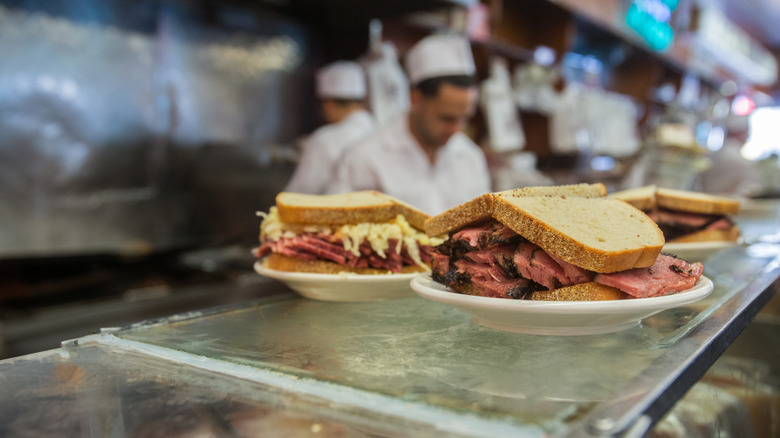Why Pastrami Sandwiches Are So Popular On The East Coast
As iconic American sandwiches go, you can't deny that pastrami sandwiches belong on the list. While you can find excellent pastrami sandwiches all over the U.S., they are particularly popular and plentiful on the East Coast, more specifically in New York, where they are the state's signature sandwich. Classically made by piling slices of hot pastrami on soft rye bread and adding a squirt of mustard, it is the kind of sandwich that is unequivocally connected with the Big Apple, particularly at such famed eateries as Katz's Delicatessen, Carnegie Deli, and Pastrami Queen, which has the best pastrami sandwich in NYC according to Anthony Bourdain. The reason the sandwich is so much more common in the East than the West is that pastrami arrived there first and found a strong fan base.
Pastrami is believed to have arrived in New York during the late 19th century when thousands of Jewish immigrants from Eastern Europe, including Romania, came to America. While modern-day pastrami is made from beef brisket, traditional recipes from Europe used goat, mutton, and goose that was cured and flavored with spices. Newly arrived immigrants found that beef was much easier to find in the United States, so they adapted and began making beef pastrami. Many opened restaurants and delicatessens where fellow immigrants would eat to enjoy a taste of home, and eventually, non-immigrants became patrons as well. As time-honored dishes and recipes often stay relevant to future generations, we continue to see pastrami sandwiches thrive in Eastern cities and towns, particularly those with large Eastern European and Jewish communities.
Pastrami has Turkish roots
Although Romanian Jews are responsible for bringing pastrami to the United States, it is believed to be the Ottoman Turks who introduced the meat preparation method to Eastern Europe. The Turkish term for the preservation technique is called pastirma, and it involves drying, salt-curing, and spice-rubbing the meat. While the Turks would primarily use beef, goat, and mutton, the Romanians mainly used goose until they came to the U.S. when beef became the meat of choice. The advent of refrigeration would again change the way pastrami was made, and purveyors began curing their briskets in a wet brine, which didn't require as much salt as was previously needed. Today, wet brines and spice rubs are still widely used in pastrami preparation, but the briskets are also often smoked and steamed before they are sliced into serving portions.
When pastrami first came to the United States by way of New York, it wasn't immediately sold in sandwiches, as is popular today. Lithuanian immigrant and kosher butcher Sussman Volk is believed to have made the first pastrami sandwich in America in 1887, but he received his pastrami recipe from a Romanian friend in exchange for a favor. The sandwiches were such a hit that Volk turned his butcher shop into a sandwich restaurant.

